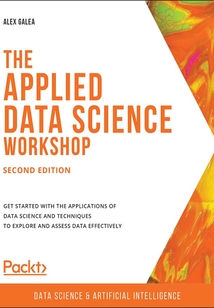首頁(yè) > 計(jì)算機(jī)網(wǎng)絡(luò) >
編程語(yǔ)言與程序設(shè)計(jì)
> The Applied Data Science Workshop最新章節(jié)目錄
舉報(bào) 

會(huì)員
The Applied Data Science Workshop
最新章節(jié):
6. Web Scraping with Jupyter Notebooks
Frombankingandmanufacturingthroughtoeducationandentertainment,usingdatascienceforbusinesshasrevolutionizedalmosteverysectorinthemodernworld.Ithasanimportantroletoplayineverythingfromappdevelopmenttonetworksecurity.Takinganinteractiveapproachtolearningthefundamentals,thisbookisidealforbeginners.You’lllearnallthebestpracticesandtechniquesforapplyingdatascienceinthecontextofreal-worldscenariosandexamples.Startingwithanintroductiontodatascienceandmachinelearning,you’llstartbygettingtogripswithJupyterfunctionalityandfeatures.You’llusePythonlibrarieslikesci-kitlearn,pandas,Matplotlib,andSeaborntoperformdataanalysisanddatapreprocessingonreal-worlddatasetsfromwithinyourownJupyterenvironment.Progressingthroughthechapters,you’lltrainclassificationmodelsusingsci-kitlearn,andassessmodelperformanceusingadvancedvalidationtechniques.Towardstheend,you’lluseJupyterNotebookstodocumentyourresearch,buildstakeholderreports,andevenanalyzewebperformancedata.BytheendofTheAppliedDataScienceWorkshop,you’llbepreparedtoprogressfrombeingabeginnertotakingyourskillstothenextlevelbyconfidentlyapplyingdatasciencetechniquesandtoolstoreal-worldprojects.
目錄(41章)
倒序
- 封面
- 版權(quán)信息
- Preface
- 1. Introduction to Jupyter Notebooks
- Introduction
- Basic Functionality and Features of Jupyter Notebooks
- Jupyter Features
- Summary
- 2. Data Exploration with Jupyter
- Introduction
- Our First Analysis – the Boston Housing Dataset
- Summary
- 3. Preparing Data for Predictive Modeling
- Introduction
- Machine Learning Process
- Approaching Data Science Problems
- Understanding Data from a Modeling Perspective
- Introducing the Human Resource Analytics Dataset
- Summary
- 4. Training Classification Models
- Introduction
- Understanding Classification Algorithms
- Summary
- 5. Model Validation and Optimization
- Introduction
- Assessing Models with k-Fold Cross Validation
- Dimensionality Reduction with PCA
- Summary
- 6. Web Scraping with Jupyter Notebooks
- Introduction
- Internet Data Sources
- Introduction to HTTP Requests
- Data Workflow with pandas
- Summary
- Appendix
- 1. Introduction to Jupyter Notebooks
- 2. Data Exploration with Jupyter
- 3. Preparing Data for Predictive Modeling
- 4. Training Classification Models
- 5. Model Validation and Optimization
- 6. Web Scraping with Jupyter Notebooks 更新時(shí)間:2021-06-18 18:27:46
推薦閱讀
- 數(shù)字媒體應(yīng)用教程
- 軟件架構(gòu)設(shè)計(jì):大型網(wǎng)站技術(shù)架構(gòu)與業(yè)務(wù)架構(gòu)融合之道
- Java面向?qū)ο蟪绦蜷_發(fā)及實(shí)戰(zhàn)
- JavaScript:Moving to ES2015
- C語(yǔ)言程序設(shè)計(jì)
- Multithreading in C# 5.0 Cookbook
- 學(xué)習(xí)OpenCV 4:基于Python的算法實(shí)戰(zhàn)
- 用戶體驗(yàn)可視化指南
- 案例式C語(yǔ)言程序設(shè)計(jì)實(shí)驗(yàn)指導(dǎo)
- Python開發(fā)基礎(chǔ)
- Android移動(dòng)應(yīng)用開發(fā)項(xiàng)目教程
- 深入淺出Python數(shù)據(jù)分析
- Arduino Electronics Blueprints
- 大象:Thinking in UML(第二版)
- 軟件測(cè)試項(xiàng)目實(shí)戰(zhàn)之功能測(cè)試篇
- Java EE應(yīng)用開發(fā)及實(shí)訓(xùn)
- Learning Akka
- React Router Quick Start Guide
- 微信公眾平臺(tái)應(yīng)用開發(fā)實(shí)戰(zhàn)
- SQL Server 2005數(shù)據(jù)庫(kù)項(xiàng)目教程
- 零基礎(chǔ)學(xué)C# 3.0
- 深入理解ElasticSearch
- Oracle數(shù)據(jù)庫(kù)基礎(chǔ)與應(yīng)用教程
- Java Persistence with MyBatis 3
- Java程序設(shè)計(jì)教程(第2版)
- Learning Qlik Sense?:The Official Guide(Second Edition)
- Spring Boot從入門到精通
- 高性能響應(yīng)式Web開發(fā)實(shí)戰(zhàn)
- Puppet 5 Essentials(Third Edition)
- Java多線程編程核心技術(shù)(第3版)

